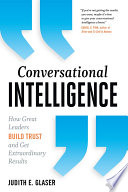

Trust is the cornerstone of effective communication. In 'Conversational Intelligence', Judith E. Glaser emphasizes that the quality of our conversations directly impacts our relationships and the outcomes we achieve. Trust creates a safe environment where individuals feel valued and understood, allowing for open dialogue and collaboration. When trust is established, it fosters a sense of belonging and encourages people to share their thoughts and ideas freely. The book outlines how leaders can cultivate trust through transparency, vulnerability, and active listening, which are essential for engaging conversations. Trust not only enhances interpersonal relationships but also drives innovation and problem-solving within teams. By prioritizing trust, organizations can create a culture that promotes healthy communication and collective growth.
Continue readingGlaser delves into the neuroscience behind conversations, explaining how our brains respond to different types of communication. The book highlights the concept of 'neural pathways' and how conversations can trigger either a threat response or a reward response in our brains. When conversations are filled with negativity, criticism, or defensiveness, they activate the amygdala, leading to a fight-or-flight response. Conversely, positive and constructive conversations activate the prefrontal cortex, which encourages creativity and collaboration. Understanding these neurological responses allows individuals to consciously choose their communication styles to foster more productive and supportive conversations. Glaser provides practical strategies for shifting conversations from a threat-based approach to a more collaborative and constructive one.
Continue readingGlaser outlines three levels of conversations: transactional, positional, and transformational. Transactional conversations are focused on exchanging information and achieving short-term goals, while positional conversations often involve debates and defending one's viewpoint. Transformational conversations, however, are where true change occurs; they involve deep listening, empathy, and co-creation of ideas. The book emphasizes the need to elevate conversations from transactional or positional levels to transformational levels to drive meaningful change in organizations and relationships. By encouraging transformational conversations, leaders can inspire their teams, foster innovation, and build a culture of collaboration that extends beyond mere transactions.
Continue readingConversational agility refers to the ability to navigate various conversational dynamics effectively. Glaser discusses how individuals can develop this skill to adapt their communication style based on the context and the audience. This includes being aware of non-verbal cues, listening actively, and adjusting one's tone and approach to suit the conversation's needs. The book offers techniques for enhancing conversational agility, such as asking open-ended questions, practicing empathy, and being mindful of one's own biases. By honing conversational agility, individuals can engage more effectively in discussions, resolve conflicts, and foster a more inclusive dialogue, ultimately leading to more productive outcomes.
Continue readingThe language we use in conversations significantly influences how messages are perceived and understood. Glaser emphasizes the power of words and the importance of choosing language that promotes connection and understanding. The book explores how certain phrases can either build rapport or create barriers, highlighting the need for mindful communication. For instance, using inclusive language fosters collaboration, while judgmental language can lead to defensiveness. Glaser provides insights into how to reframe language to enhance conversations, encouraging readers to be aware of their word choices and the implications they carry. By refining our language, we can create more meaningful and constructive interactions.
Continue readingGlaser argues that organizations must cultivate a culture of conversational intelligence to thrive in today's complex environment. This involves training leaders and team members to engage in effective conversations that promote trust, collaboration, and innovation. The book outlines practical steps for integrating conversational intelligence into organizational practices, such as implementing training programs, encouraging feedback, and creating safe spaces for dialogue. By prioritizing conversational intelligence, organizations can enhance employee engagement, improve decision-making, and foster a culture of continuous learning. Glaser emphasizes that building this culture is not a one-time effort but an ongoing commitment that requires dedication and practice.
Continue readingIn the final chapters, Glaser explores the implications of conversational intelligence in the context of the future of work. As organizations become more diverse and remote, the ability to communicate effectively is more critical than ever. The book discusses how conversational intelligence can bridge gaps between different cultures, backgrounds, and perspectives, fostering a more inclusive work environment. Glaser also highlights the role of technology in facilitating conversations, such as virtual collaboration tools, while cautioning against the potential pitfalls of miscommunication in digital interactions. By embracing conversational intelligence, organizations can navigate the complexities of the modern workplace and harness the power of collective intelligence.
Continue reading